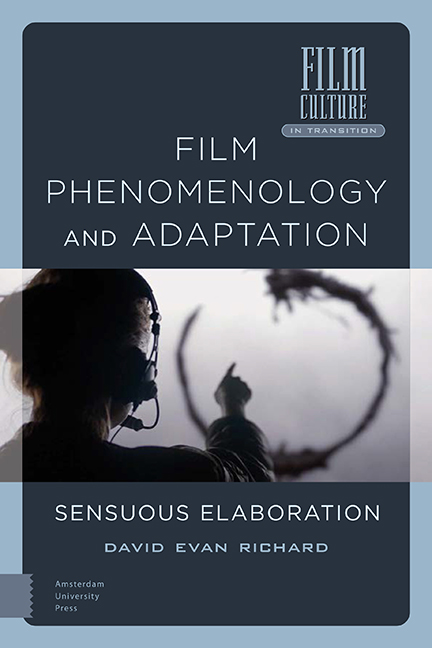Book contents
- Frontmatter
- Contents
- Acknowledgements
- List of Figures
- Introduction: A ‘Fleshly Dialogue’
- 1 Grave Visions: Visual Experience and Adaptation
- 2 Resonance and Reverberation: Sounding Out Screen Adaptation
- 3 Textural Analysis: Touching Adaptation
- 4 Textures of Imagination
- 5 (Re-)Mediating Memory’s Materiality
- Conclusion: Body Language
- Bibliography
- Filmography
- Index
2 - Resonance and Reverberation: Sounding Out Screen Adaptation
Published online by Cambridge University Press: 27 May 2021
- Frontmatter
- Contents
- Acknowledgements
- List of Figures
- Introduction: A ‘Fleshly Dialogue’
- 1 Grave Visions: Visual Experience and Adaptation
- 2 Resonance and Reverberation: Sounding Out Screen Adaptation
- 3 Textural Analysis: Touching Adaptation
- 4 Textures of Imagination
- 5 (Re-)Mediating Memory’s Materiality
- Conclusion: Body Language
- Bibliography
- Filmography
- Index
Summary
Abstract
This chapter attends to the phenomenological quality of sound and how it contributes to the experience and appreciation of adaptation. Attending to an adaptation's soundscape not only reveals how it faithfully ‘re-sounds’ its source novel through the use of dialogue, but also how an adaptation might use sound to be creatively divergent from its source. This chapter therefore not only examines how an adaptation's non-diegetic score can smooth its narrative structure or give emotional and psychological insight into its characters. But further, this chapter also examines how the warped and uncanny use of the actor's voice—or an extremely atonal soundscape and score—can palpably affect the spectator. In doing so, this chapter examines how sound—both ‘faithful’ and ‘unfaithful’ recording of its source—intersects with adaptations both ‘faithful’ and wonderfully ‘unfaithful’ to its source.
Keywords: adaptation, phenomenology, sound, The Hours (Stephen Daldry, 2002), The Exorcist (William Friedkin, 1973), Under the Skin (Jonathan Glazer, 2013)
Prelude
In the previous chapter, I examined how literary narratives can be brought to the screen in glorious and visually spectacular displays that resonate with the spectator. However, as Siegfried Kracauer explains, ‘our eyes cannot register a single object without our ears participating in the process’. In this chapter, then, I attend to how screen adaptations ‘resonate’ with the spectator in a more fundamental sense. As the etymology of ‘resonate’ is the Latin resonare, to re-sound, I will draw attention to how the audible dimension of screen adaptation quite literally resonates and reverberates within the spectator. This chapter analyses how sound design strategies thicken our engagement with screen adaptations, from the voice in The Exorcist (William Friedkin, 1973) and music as an adaptive strategy in The Hours (Stephen Daldry, 2002) and Under the Skin (Jonathan Glazer, 2013). Although this cluster of adaptations might appear disparate, they are united through their creative use of the voice, music, and the way in which they reveal the acoustic texture and density to what Béla Balázs describes as ‘the intimate whisperings of nature’.
Attending to an adaptation's soundscape not only reveals how it faithfully ‘re-sounds’ its source novel through the use of dialogue, but also how an adaptation might use sound to be creatively divergent from its source.
- Type
- Chapter
- Information
- Film Phenomenology and AdaptationSensuous Elaboration, pp. 73 - 100Publisher: Amsterdam University PressPrint publication year: 2021



